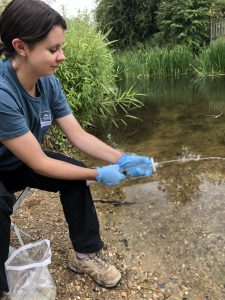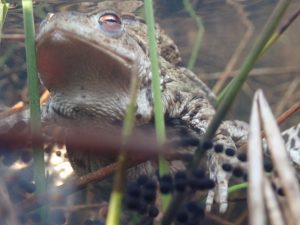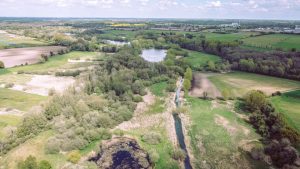100 local volunteers complete eDNA survey of freshwaters in the Brecks
26th January 2023
Heritage Lottery-funded research involving more than 100 local volunteers has revealed that freshwater fish, amphibians and aquatic mammals rely on a wide range of different waterbodies in the Brecks. The new study, which used cutting-edge technology, highlights the importance of protecting the whole landscape to ensure we have high quality habitats for freshwater wildlife.
Undertaken as part of the Brecks Fen Edge & Rivers Landscape Partnership Scheme (BFER) by national wildlife conservation charity Freshwater Habitats Trust, the survey shows that many species use small standing waterbodies, including ponds and small lakes, as well as – or instead of – running waters, such as streams and rivers. The study found that even fish such as the European Eel, which are usually associated with rivers, travel overland on wet nights to live in these alternative freshwater homes.
The research, which was the first of its kind in the Brecks, also revealed standing waters to be the cleanest freshwater habitats. Surveys conducted across more than 70 sites found 71% of standing waterbodies to be clean and unpolluted, compared with just 17% of running waterbodies.
Although the level of pollution in streams and rivers was similar to the national pattern, a much higher proportion of ponds and small lakes are unpolluted in the Brecks than in most parts of the country. Large numbers of small waterbodies are located on the area’s STANTA military training area, as well as in nature reserves, both landscapes where there is little use of chemical treatments and fertilisers. This means that the ponds and lakes they support are fed by cleaner water than in most of the surrounding farmed countryside.
 More than 100 volunteers took part in Testing the Water.
More than 100 volunteers took part in Testing the Water.
The surveys were carried out through the Citizen Science: Testing the Water project, as part of the Brecks Fen Edge & Rivers Landscape Partnership Scheme (BFER LPS), supported by the National Lottery Heritage Fund. To help with the surveys, Freshwater Habitats Trust engaged with local schools and recruited and trained more than 100 volunteers from the Brecks area, which covers 1,000 square kilometres across the west of Norfolk and Suffolk.
Taking samples from 75 ponds, streams, rivers, lakes and ditches, the volunteers carried out water quality testing to measure levels of two pollutants: nitrate and phosphate. They also used a cutting-edge technique called ‘environmental DNA’ or ‘eDNA’ testing to detect which species of fish, amphibians and aquatic mammals were living in or visiting the waterbodies. This detects invisible traces of an animal’s DNA released into the environment from its shed skin, hair, faeces or eggs.
 Common Toad. Photo by Martin Roberts.
Common Toad. Photo by Martin Roberts.
The most frequently-detected amphibian was the Common Toad, the eDNA of which was in 18 standing and running waterbodies. Although it is still relatively widespread, the Common Toad has declined in recent years and, in Britain, is now given protection under the Natural Environment and Rural Communities Act 2006. Great Crested Newts, a species of high conservation importance, were also detected at key sites within the Brecks landscape using the eDNA technique.
A total of 26 fish species were recorded, with the most common being Three-spined and Nine-spined Stickleback. These small fish were found in a range of waterbodies, including ponds, lakes, rivers and ditches. Volunteers also found evidence of several elusive aquatic mammals, including Water Vole and Otter, an indication of the values of this survey method for finding otherwise tricky to survey species.
The volunteers also detected eDNA of a number of terrestrial mammal and bird species at a range of the still and standing waterbodies. It is likely that these species would be moving about the landscape but stopping at these waterbodies to drink or find prey.
 Freshwater Habitats Trust Director of Policy and Research Dr Naomi Ewald said: “This research has given us some fascinating insights into how animals are using a range of different waterbodies and highlights the importance of protecting the whole freshwater environment.
Freshwater Habitats Trust Director of Policy and Research Dr Naomi Ewald said: “This research has given us some fascinating insights into how animals are using a range of different waterbodies and highlights the importance of protecting the whole freshwater environment.
“Our surveys revealed that most clean water in the Brecks is in standing waters, including ponds, pools and lakes. Polluted water is known to be the main cause of the sharp decline in freshwater biodiversity. Most freshwater plants and animals have evolved over millions of years in conditions where nutrients are naturally scarce and are now struggling to adapt to the high levels of nutrients, like phosphate and nitrate, which we now find in most waterbodies.
“It is very difficult to clean up rivers and streams so a more realistic way of giving Breckland freshwater wildlife a refuge would be to create more standing waters which it is easier to keep unpolluted – and protect the clean waterbodies we already have. Protecting the best and building out from these will be critical for the conservation of the Brecks freshwater wildlife in the future and this survey has provided us with some invaluable data to help us achieve that.”
Freshwater Habitats Trust Project Officer Anne Carter said: “We are so pleased to have had the opportunity to survey the Brecks and understand more about how different animals are using the range of waterbodies found here. Despite being near to the Norfolk Broads, the Brecks is traditionally thought of as a dry landscape but it is, in fact, home to remarkable freshwater wildlife, partly thanks to the ancient pingos ponds and fluctuating meres, which are characteristic of this region.
“We’re very grateful to all the volunteers, who put so much time and enthusiasm into this project, enabling us to carry out some really groundbreaking research. Thanks to their efforts, we now know far more about Breckland’s freshwater wildlife and can work with other conservation agencies to help protect it.”
Nick Dickson, BFER Scheme Manager said: “It’s incredibly exciting to be working with local citizen science volunteers to deliver cutting edge survey techniques in the Brecks. Working with Freshwater Habitats Trusts means that what we’re doing is not only appropriate and effective, but that the work being undertaken helps to celebrate the unique natural heritage of the area and goes on to support and inform land management and conservation decisions for the future. This could not have been done without our volunteers, the support from Freshwater Habitats Trust, and the National Lottery Heritage Fund.”
Freshwater Habitats Trust designated the Brecks an Important Freshwater Area following indepth analysis, which showed it to be home to an exceptional range of freshwater wildlife. The region is especially known for its pingos – natural ponds that were formed during the last ice age – which, thanks to their ancient origins and freedom from water pollution, are home to unique communities of plants and animals.
Over the next 12 months, Freshwater Habitats Trust will collaborate with landowners in the Brecks to carry out more surveys and will work with volunteers to measure the extent of clean water areas around biodiversity hotspots. The charity will also develop the Freshwater Network – a national network of wilder, cleaner and connected freshwaters – focusing on Important Freshwater Landscapes, such as the Brecks.

